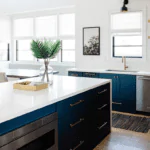Sustainable Interior Design Tips On A Budget
Sustainable interior design is no longer a niche trend but a vital way to create beautiful, environmentally-friendly living spaces. However, many people believe that going green in interior design means spending a fortune. The truth is, you can create a sustainable and eco-friendly interior on a budget by making thoughtful choices and implementing creative ideas. In this blog, we will explore a range of sustainable interior design tips that are inexpensive, while helping you reduce your carbon footprint and enhance your home’s beauty and functionality.
- Include Energy-Efficient Design & Architecture
The most fundamental aspect of an eco-friendly home is construction. So, if you have the opportunity, choose energy-efficient construction and design. It is preferable to reduce the need for additional heating, lighting, and energy for appliances.
This strategy incorporates non-carbon-based renewable energy sources like as solar power, as well as structural and architectural innovation. For example, insulating windows, curtains, rugs, and using a light color scheme reduce the demand for heating and lighting.
- Hire a Sustainable Interior Designer
Working with an eco-friendly interior designer is a proven approach to build a green home. For starters, sustainable interior designers are knowledgeable about eco-friendly procedures. They can select furnishings, fittings, and appliances that have the least environmental effect. Designers also promote local companies and improve indoor air quality.
These options are not always as obvious as they appear. Linoleum, for example, is a better choice for flooring than vinyl. The reason for this is that linoleum is mostly made of jute, a natural fabric. Vinyl is also known to be carcinogenic. This is one way a sustainable interior designer might help you make design choices.
- Repurpose and Upcycle
One of the most budget-friendly ways to achieve sustainable interior design is by repurposing and upcycling old furniture and decor. Instead of throwing out that old dresser or side table, consider giving it a fresh coat of paint or stain, or sanding and refinishing it. You can create a unique and stylish piece while preventing unnecessary waste.
Additionally, check out thrift stores, garage sales, and online marketplaces for second-hand furniture and accessories. Not only will this save you money, but it also reduces the demand for new furniture production.
- Indoor Plants
Bringing nature into your home is a cost-effective way to enhance the aesthetics and air quality of your space. Indoor plants not only purify the air but also add a touch of greenery and tranquility to your interior. Look for low-maintenance plants like snake plants, pothos, or succulents that don’t require excessive care.
To save even more money, consider propagating plants from cuttings or seeds. You can also place your plants in upcycled containers like mason jars, tin cans, or vintage teacups for a quirky and sustainable touch.
- Energy-Efficient Lighting
Switching to energy-efficient lighting can significantly reduce your energy consumption and utility bills. LED and CFL bulbs are cost-effective and long-lasting alternatives to traditional incandescent bulbs. Furthermore, these bulbs emit less heat, reducing your home’s cooling costs during the warmer months.
To maximize natural lighting, use light-colored curtains or blinds that allow sunlight to penetrate your space. This not only reduces the need for artificial lighting but also adds a warm and inviting ambiance to your interior.
Sustainable interior design doesn’t have to be expensive. By incorporating the tips and ideas mentioned above, you can transform your space into an eco-friendly haven while staying within your budget. Remember that even tiny, deliberate adjustments may have a big influence on lowering your carbon footprint and helping to a greener, more sustainable future. So, get creative, reuse, and make sustainable decisions that benefit both your home and the environment.






